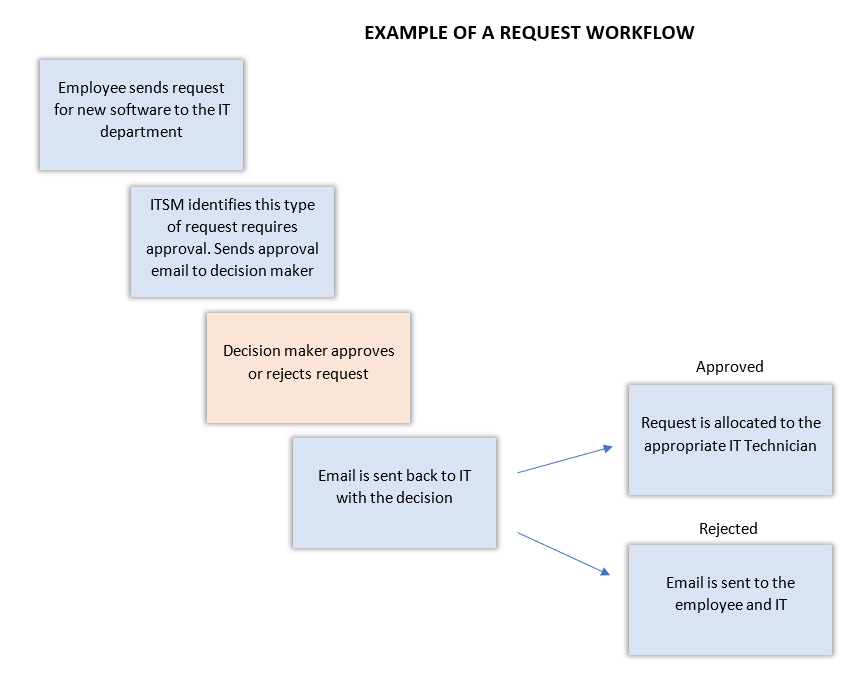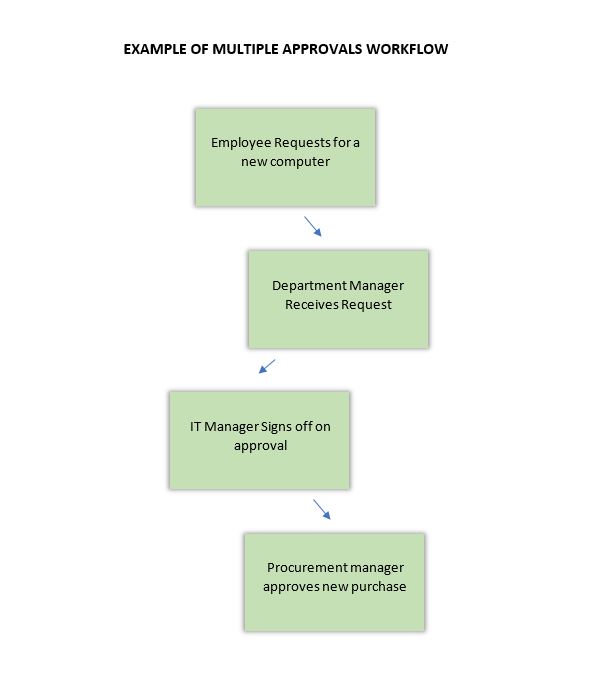How IT Service Management Improves Approvals In IT Workflows
When employees start submitting similar IT requests, the IT department uses an IT Service Management (ITSM) solution to put workflows into place. Workflows reduce repetitive tasks within larger business processes.
In the example below, an employee is requesting a new marketing software. As you will notice, after an employee submits a request, the entire workflow is automatic except for one step- the manager’s approval. If IT needs approval for a request, they usually send an email to the decision-makers. This can be quite an outdated method of getting approval with clear problems. Yet, a modern ITSM can manage the entire process supporting many workflows ensuring the approval process is effective.

Speed Up your Approval Process with these 5 ITSM workflows:
1. Many Approval Steps
There are some requests that need approval from a few people but only need one approval to move forward. Instead of waiting until the decision-makers approve the request, ITSM can move the request along after getting just one approval. In other instances, there are some requests that need many approvals. ITSM can be set up to default for a certain number of approvals before the request can move forward. For example, seven people receive the request but after it gets three approvals the request can move forward. This workflow is ideal when for urgent situations by preventing traffic.

2. Opportunity To Delegate
Approval processes will also continue to move forward by choosing delegates. If someone is on vacation, the approval process will not slow down for the extension of that person’s vacation. Delegates can make the approvals in the original approver’s place. When there is no delegate, the process can be set to move along regardless of the approval, unless that person is the only approval required. So, ITSM establishes appropriate workflows throughout the business and gets the appropriate people involved to make IT workflows work smoothly.
3. Updated Information
When a request enters in an ITSM system or request management solution, it automatically sends an email to the appropriate decision-makers. But what happens if the requester realizes there’s a mistake in the request after it is already sent out?
In an optimal ITSM solution, the request can update. Instead of re-emailing the update to all recipients, it will notify those who already approved or rejected the request. For example, 10 decision-makers receive the request. The requester realizes there’s a mistake with the date in the request after three decision-makers already viewed it. The ITSM solution updates the request and only sends an email notification about the update to those who opened it. This ensures the IT workflows are not overwhelming to the decision-makers and prevent the influx of emails for one request. It also saves time for the requester since there’s no need to worry about rewriting new emails.
In another situation, the request can update as a result of the decision-makers criticism. For example, if the first decision-maker rejects the request due to a conflicting event on that date, suggesting a new date that she thinks would be good, the system would automatically handle the update, re-sending the emails to the other recipients. An ITSM solution is an effective approach to organizing requests and changes within them. Another advantage is that the solution tracks the history of changes, which is usually not practical via emails.
4. Email Reminders
The people approving the requests are often very busy. It is easy for them to ignore or forget emails while doing other tasks. To get their approval, sometimes all it takes is a reminder. IT can set up email reminders after an email isn’t read or responded to for a certain period of time. This encourages a response within a timely manner, avoids lost approvals in inboxes and prevents the IT department from chasing after people.
5. Details of Requester
In certain cases, decision-makers or managers cannot make a decision about a request because they do not have enough information. The IT department can automatically set up the requests to include the requester’s details including name, department, phone number, and email. ITSM has the capability of transferring the data from the initial request to the approval email, as long as it is set up in the system. After, the decision-maker will have all the information he or she needs to make a decision or can contact the requester for more information. This workflow avoids unnecessary delays and prevents decision-makers from wasting time.
The benefits of using proper workflows include:
1. Reduces the time it takes to complete a process,
2. Establishes open communication lines between the departments involved
3. It saves costs by being more efficient.
An ITSM solution improves IT workflows and may significantly help the approval process within your organization. ITSM automatically sends out email reminders when a request isn’t opened, after a certain period of time. By including the requester’s details in an approval email, information is readily available for decision-makers to make a decision without any delays. Your ITSM can be set up to get multiple approvals regardless of absences. Finally, after sending out requests, update them after and avoid bothering decision-makers with different variations for the same request.
Share this blog with your coworkers!
If you need a similar system, check out VIZOR here!
Need a IT Asset Management Tool?





